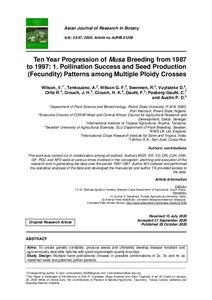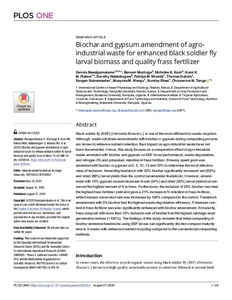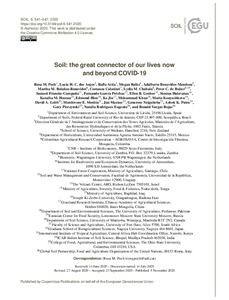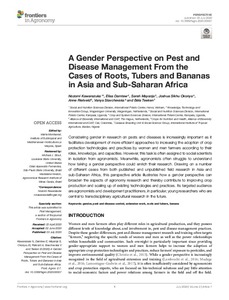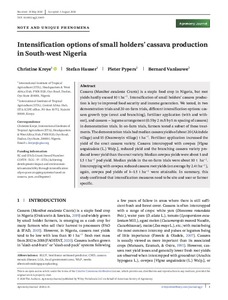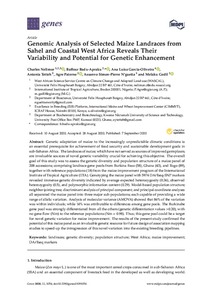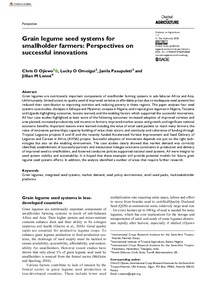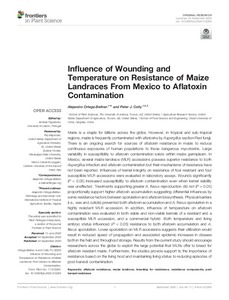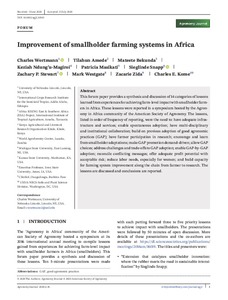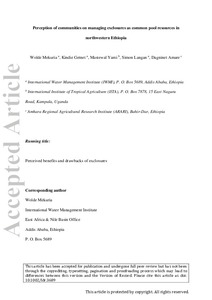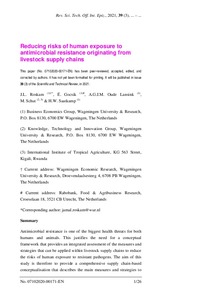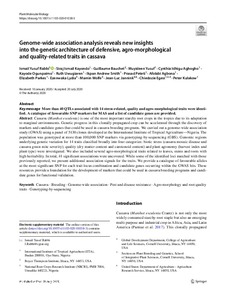Welcome to the International Institute of Tropical Agriculture Research Repository
Journal and Journal Articles: Recent submissions
Now showing items 1161-1180 of 5271
-
Ten year progression of Musa breeding from 1987 to 1997: 1. Pollination success and seed production (Fecundity) patterns among multiple ploidy crosses
(2020)Aims: To create genetic variability, produce seeds and ultimately develop disease resistant and agronomically desirable hybrids with good organoleptic quality bunches. Study Design: Multiple hand pollinations/ crosses in possible combinations of 2x, 3x and 4x as maternal/ seed and paternal/ pollen parents. Place and Duration of Study: International Institute of Tropical Agriculture High Rainfall Station (IITA), Onne, Rivers State, Nigeria. 1987 to 1997. Methodology: Utilizing over 320 landraces, ... -
Biochar and gypsum amendment of agroindustrial waste for enhanced black soldier fly larval biomass and quality frass fertilizer
(2021)Black soldier fly (BSF) (Hermetia illucens L.) is one of the most efficient bio-waste recyclers. Although, waste substrate amendments with biochar or gypsum during composting process are known to enhance nutrient retention, their impact on agro-industrial waste have not been documented. Hence, this study focuses on a comparative effect of agro-industrial waste amended with biochar and gypsum on BSF larval performance, waste degradation, and nitrogen (N) and potassium retention in frass fertilizer. ... -
Soil: the great connector of our lives now and beyond COVID-19
(2020-11-05)Humanity depends on the existence of healthy soils, both for the production of food and for ensuring a healthy, biodiverse environment, among other functions. COVID-19 is threatening food availability in many places of the world due to the disruption of food chains, lack of workforce, closed borders and national lockdowns. As a consequence, more emphasis is being placed on local food production, which may lead to more intensive cultivation of vulnerable areas and to soil degradation. In order to ... -
A gender perspective on pest and disease management from the cases of roots, tubers and bananas in Asia
(2020)Considering gender in research on pests and diseases is increasingly important as it facilitates development of more efficient approaches to increasing the adoption of crop protection technologies and practices by women and men farmers according to their roles, knowledge, and capacities. However, this task is often assigned to social scientists in isolation from agronomists. Meanwhile, agronomists often struggle to understand how taking a gender perspective could enrich their research. Drawing on ... -
Intensification options of small holders’ cassava production in south‐west Nigeria
(2020)Cassava (Manihot esculenta Crantz) is a staple food crop in Nigeria, but root yields hardly exceed 10 t ha−1. Intensification of small holders’ cassava production is key to improved food security and income generation. We tested, in two demonstration trials and 20 on‐farm trials, different intensification options: cassava growth type (erect and branching), fertilizer application (with and without), and cassava − legume arrangement (0.5 by 2 m/1 by 1 m spacing of cassava) in demonstration trials. ... -
Perspectives on global mycotoxin issues and management from the mycokey maize working group
(2020)During the last decade, there have been many advances in research and technology that have greatly contributed to expanded capabilities and knowledge in detection and measurement, characterization, biosynthesis, and management of mycotoxins in maize. MycoKey, an EU‐funded Horizon 2020 project, was established to advance knowledge and technology transfer around the globe to address mycotoxins impacts in key food and feed chains. MycoKey included several working groups comprised of international ... -
Genomic analysis of selected maize landraces from Sahel and Coastal west Africa reveals their variability and potential for genetic enhancement
(2020)Genetic adaptation of maize to the increasingly unpredictable climatic conditions is an essential prerequisite for achievement of food security and sustainable development goals in sub-Saharan Africa. The landraces of maize; which have not served as sources of improved germplasm; are invaluable sources of novel genetic variability crucial for achieving this objective. The overall goal of this study was to assess the genetic diversity and population structure of a maize panel of 208 accessions; ... -
Grain legume seed systems for smallholder farmers: perspectives on successful innovations
(2020)Grain legumes are nutritionally important components of smallholder farming systems in sub-Saharan Africa and Asia. Unfortunately, limited access to quality seed of improved varieties at affordable prices due to inadequate seed systems has reduced their contribution to improving nutrition and reducing poverty in these regions. This paper analyses four seed systems case studies: chickpea in Ethiopia and Myanmar; cowpea in Nigeria; and tropical grain legumes in Nigeria, Tanzania and Uganda highlighting ... -
Influence of wounding and temperature on resistance of maize landraces from Mexico to aflatoxin contamination
(2020)Maize is a staple for billions across the globe. However, in tropical and sub-tropical regions, maize is frequently contaminated with aflatoxins by Aspergillus section Flavi fungi. There is an ongoing search for sources of aflatoxin resistance in maize to reduce continuous exposures of human populations to those dangerous mycotoxins. Large variability in susceptibility to aflatoxin contamination exists within maize germplasm. In Mexico, several maize landrace (MLR) accessions possess superior ... -
Improvement of smallholder farming systems in Africa
(2020-07-17)This forum paper provides a synthesis and discussion of 14 categories of lessons learned from experiences for achieving farm‐level impact with smallholder farmers in Africa. These lessons were reported in a symposium hosted by the Agronomy in Africa community of the American Society of Agronomy. The lessons, listed in order of frequency of reporting, were the need to: have adequate infrastructure and services; enable spontaneous adoption; have multi‐disciplinary and institutional collaboration; ... -
Perception of communities on managing exclosures as common pool resources in northwestern Ethiopia
(2021-01-15)Understanding the different perceptions of the local community regarding the use and management of common pool resources, such as exclosures, could better support targeted interventions by government and development partners. Here, we report on a study conducted in the Gomit watershed, northwestern Ethiopia, using a survey and key informant interviews, to examine community perceptions on (a) the biophysical condition (i.e., challenge of land degradation and restoration), (b) the action situations ... -
Genome-wide association analysis for tuber dry matter and oxidative browning in water yam (Dioscorea alata L.)
(2020)Yam (Dioscorea spp.) is a nutritional and medicinal staple tuber crop grown in the tropics and sub-tropics. Among the food yam species, water yam (Dioscorea alata L.) is the most widely distributed and cultivated species worldwide. Tuber dry matter content (DMC) and oxidative browning (OxB) are important quality attributes that determine cultivar acceptability in water yam. This study used a single nucleotide polymorphism (SNP) assay from a diversity arrays technology (DArT) platform for a genome-wide ... -
Improvement of smallholder farming systems in Africa
(2020-07-17)This forum paper provides a synthesis and discussion of 14 categories of lessons learned from experiences for achieving farm‐level impact with smallholder farmers in Africa. These lessons were reported in a symposium hosted by the Agronomy in Africa community of the American Society of Agronomy. The lessons, listed in order of frequency of reporting, were the need to: have adequate infrastructure and services; enable spontaneous adoption; have multi‐disciplinary and institutional collaboration; ... -
Reducing risks of human exposure to antimicrobial resistance originating from livestock supply chains
(2021)Antimicrobial resistance is one of the biggest health threats for both humans and animals. This justifies the need for a conceptual framework that provides an integrated assessment of the measures and strategies that can be applied within livestock supply chains to reduce the risks of human exposure to resistant pathogens. The aim of this study is therefore to provide a comprehensive supply chain-based conceptualisation that describes the main measures and strategies to Rev. Sci. Tech. Off. Int. ... -
Evaluation of nutritional properties of cassava-legumes snacks for domestic consumption: consumer acceptance and willingness to pay in Zambia
(2020-08-25)High-quality cassava flour (HQCF) is a cheaper alternative to wheat in the production of snacks. This study assessed the nutritional properties and consumer acceptability of cassava-legume snacks in Zambia. Cassava snacks were made from 100% HQCF, 50:50 cassava-soybean flour blend, 50:50 cassava-cowpea flour blend and 100% wheat flour as the control. The samples were analyzed for nutritional, functional and anti-nutritional properties using standard laboratory methods. Also, a well-outlined ... -
Genome-wide association analyses reveal the genetic basis of biomass accumulation under symbiotic nitrogen fixation in African soybean
(2020)Symbiotic nitrogen fixation (SNF) increases sustainability by supplying biological nitrogen for crops to enhance yields without damaging the ecosystem. A better understanding of this complex biological process is critical for addressing the triple challenges of food security, environmental degradation, and climate change. Soybean plants, the most important legume worldwide, can form a mutualistic interaction with specialized soil bacteria, bradyrhizobia, to fix atmospheric nitrogen. Here we report ... -
Genome-wide association study of Striga resistance in early maturing white tropical maize inbred lines
(2020)Background: Striga hermonthica (Benth.) parasitism militates against increased maize production and productivity in savannas of sub-Saharan Africa (SSA). Identification of Striga resistance genes is important in developing genotypes with durable resistance. So far, there is only one report on the existence of QTL for Striga resistance on chromosome 6 of maize. The objective of this study was to identify genomic regions significantly associated with grain yield and other agronomic traits under ... -
Genome-wide association analysis reveals new insights into the genetic architecture of defensive, agro-morphological and quality-related traits in cassava
(2020)Cassava (Manihot esculenta) is one of the most important starchy root crops in the tropics due to its adaptation to marginal environments. Genetic progress in this clonally propagated crop can be accelerated through the discovery of markers and candidate genes that could be used in cassava breeding programs. We carried out a genome-wide association study (GWAS) using a panel of 5,310 clones developed at the International Institute of Tropical Agriculture - Nigeria. The population was genotyped at ... -
Genetic diversity and population structure of maize inbred lines with varying levels of resistance to striga hermonthica using agronomic trait-based and SNP markers
(2020)Striga hermonthica is a serious biotic stress limiting maize production in sub-Saharan Africa. The limited information on the patterns of genetic diversity among maize inbred lines derived from source germplasm with mixed genetic backgrounds limits the development of inbred lines, hybrids, and synthetics with durable resistance to S. hermonthica. This study was conducted to assess the level of genetic diversity in a panel of 150 diverse maize inbred lines using agronomic and molecular data and ... -
A review of varietal change in roots, tubers and bananas: consumer preferences and other drivers of adoption and implications for breeding
(2020)This review of the literature on varietal change in sub‐Saharan Africa looks in detail at adoption of new varieties of bananas in Uganda, cassava in Nigeria, potato in Kenya, sweetpotato in Uganda and yams in Côte d’Ivoire. The review explored three hypotheses about drivers of varietal change. There was a strong confirmation for the hypothesis that insufficient priority given to consumer‐preferred traits by breeding programmes contributes to the limited uptake of modern varieties (MVs) and low ...

